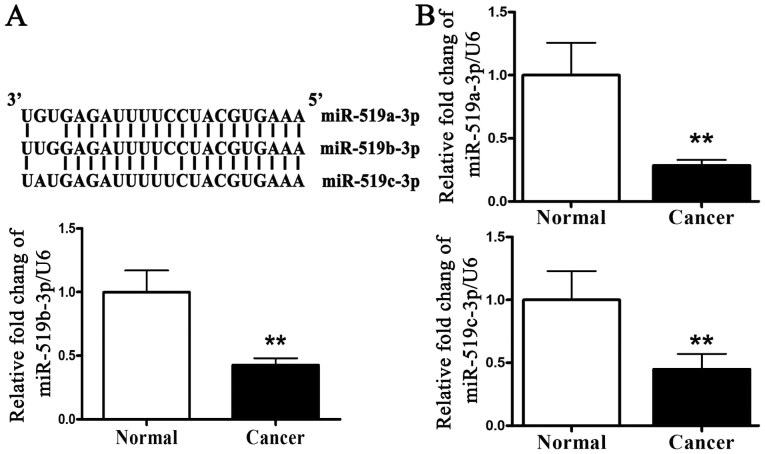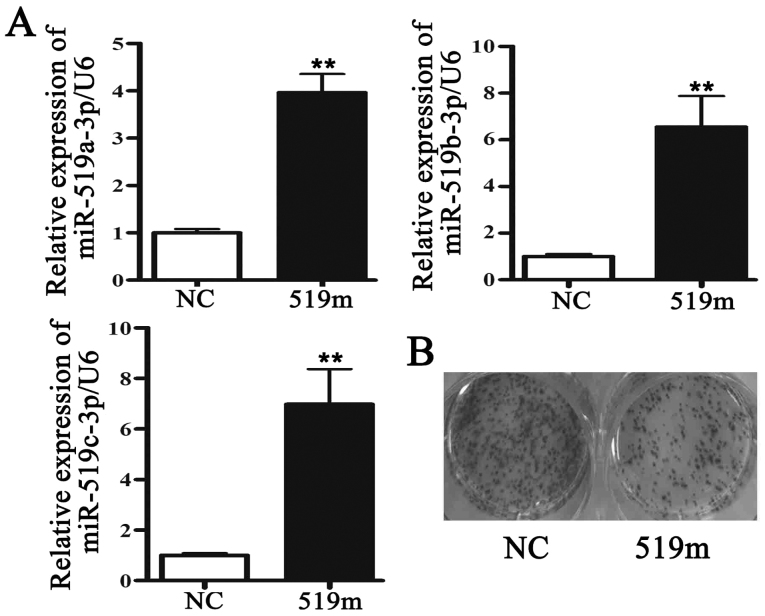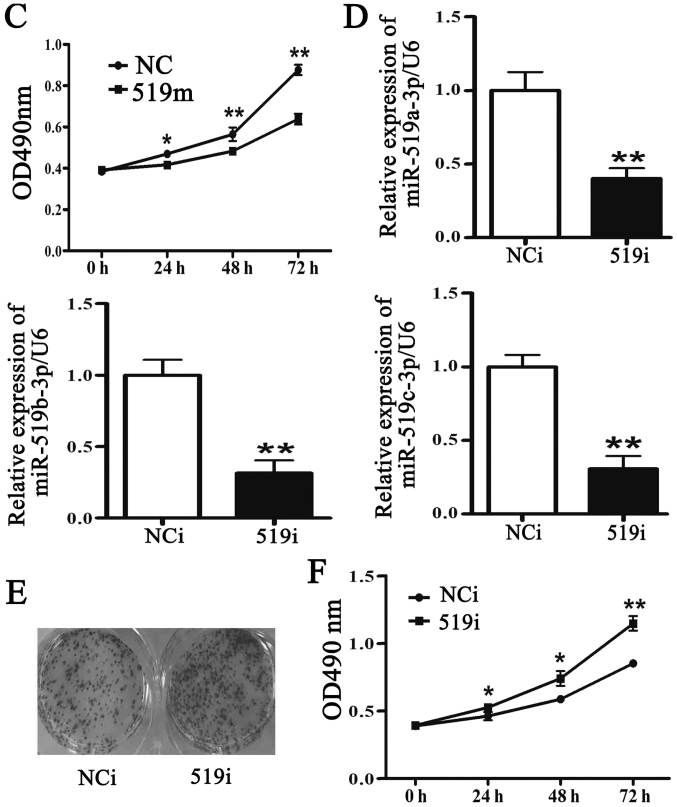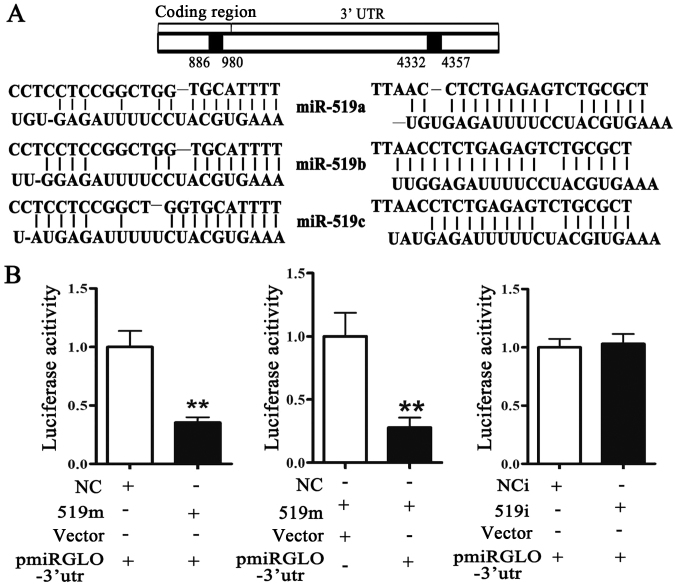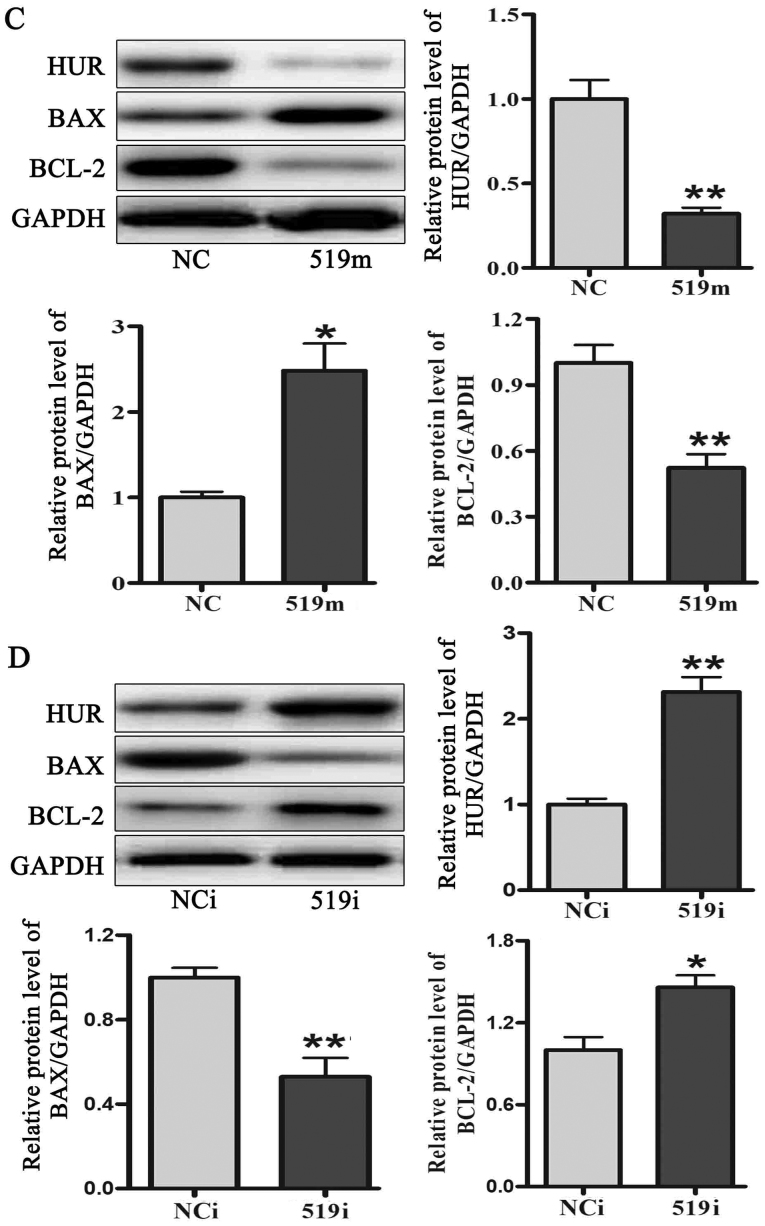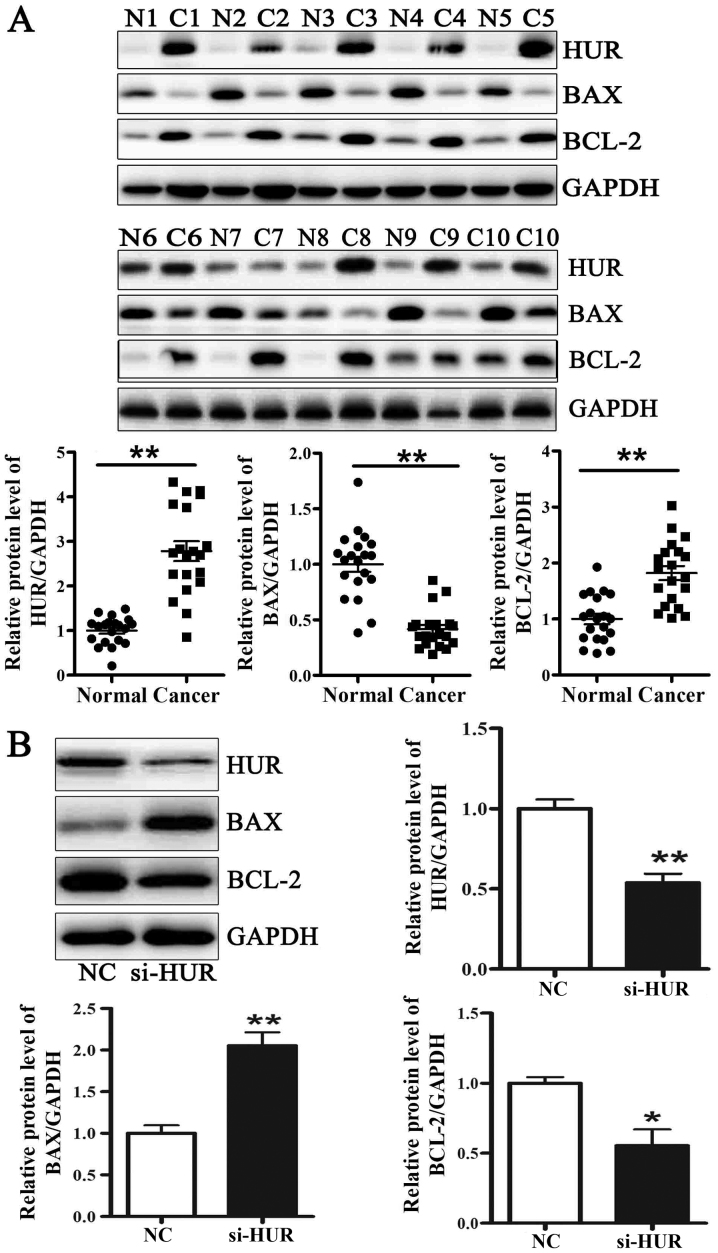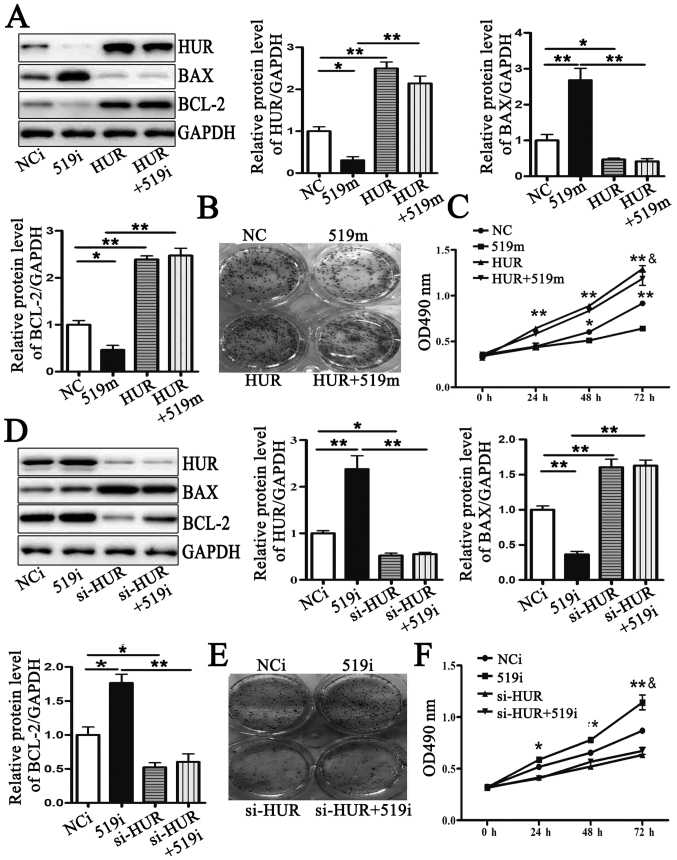Abstract
Breast cancer is one of the most prevalent types of cancer among women that leads to millions of deaths worldwide every year. The mechanisms of breast cancer pathogenesis remain unclear. It has been reported that aberrant expression of miR-519, is associated with breast cancer development; however, the effects of miR-519 on breast cancer cell proliferation remain unknown. Therefore, the present study aimed to determine whether miR-519 could regulate breast cancer cell proliferation. A total of 20 pairs of primary breast cancer and adjacent normal tissues were collected from patients with breast cancer. miR-519 expression level was determined by reverse transcription-quantitative polymerase chain reaction. Furthermore, miR-519 mimics or inhibitors were transfected into breast cancer MCF-7 cells in order to up- or downregulate miR-519 expression. Subsequently, human antigen R (HUR), BCL-2 and BAX protein levels were analyzed by western blotting. MCF-7 cell proliferation was assessed using MTT and colony formation assays. A luciferase assay was performed to verify whether miR-519 could directly bind to HUR mRNA. The results demonstrated that miR-519 expression level was lower in primary breast cancer tissues compared with adjacent normal tissues. Furthermore, miR-519 overexpression and downregulation inhibited and stimulated MCF-7 cell proliferation, respectively. In addition, the results from luciferase assay demonstrated that HUR was a target of miR-519. HUR overexpression could reverse the effect of miR-519 mimics on MCF-7 cell proliferation, whereas HUR silencing could rescue the effect of miR-519 inhibitors on MCF-7 cell proliferation. These findings suggested that miR-519 may regulate MCF-7 cell proliferation by targeting HUR.
Keywords: miR-519, human antigen R, breast cancer, BCL-2, BAX
Introduction
Breast cancer is one of the most common types of cancer in women that is responsible for high number of cancer-associated mortality cases worldwide (1). Each year, ~1.7 million new patients are diagnosed with breast cancer, and >0.5 million women die from breast cancer worldwide (2). Early diagnosis and treatment could reduce the mortality rate of patients with breast cancer. However, numerous patients are diagnosed at an advanced stage, which is the major reason for frequent mortality (3). The main treatments for breast cancer include chemotherapy, surgery, targeted therapy, hormone replacement therapy and radiation therapy (4). There are numerous causes of breast cancer, including lifestyle (obesity, alcohol, Western-style diet) (5), depression and anxiety disorder (6) and gene mutations, including breast cancer (BRCA) gene mutation (7); however, the mechanisms underlying breast cancer pathogenesis remain unclear.
MicroRNAs (miRs) represent a class of 21–23 nucleotides long small non-coding RNAs that can act as oncogenes (8) or tumor suppressors (9) in various types of cancer, including gastrointestinal (10), liver (11), pancreatic (12), ovarian (13), lung (14) and breast cancer (15). miRs can bind directly to the 3′-untranslated region (UTR) of target genes to negatively regulate protein expression (16). It has been reported that miRs can regulate the proliferation, differentiation, migration, metastasis and apoptosis of cancer cells. In addition, numerous miRs are associated with breast cancer pathogenesis. For example, miR-454-3p can promote breast cancer metastasis by regulating Wnt/β-catenin signaling pathway (15). Furthermore, miR-29a contributes to breast cancer cell epithelial-mesenchymal transition, migration and invasion by targeting suppressor of variegation 4–20 homolog 2 (17). In addition, miR-449b-5p suppresses the proliferation and invasion of breast cancer cells by regulating the cell cycle-related and expression elevated protein in tumor-mediated Wnt/β-catenin signaling (18).
The miR-519 family is located on human chromosome 9 and includes miR-519a-3p, miR-519b-3p, miR-519c-3p, miR-519a-5p and miR-519b-5p. miR-519a-3p, miR-519b-3p and miR-519c-3p have similar sequences and share the same seed sequence (19). It has been reported that the miR-519 family is associated with cancer development. For example, miR-519 suppresses nasopharyngeal carcinoma cell proliferation by targeting the oncogene upregulated gene 4/upregulator of cell proliferation (20). However, the role of miR-519 in the development of breast cancer remains unknown. The present study demonstrated that miR-519 was downregulated in primary breast cancer tissues. The findings from this study suggested that miR-519 may regulate breast cancer cell proliferation by targeting human antigen R (HUR).
Materials and methods
Clinical breast cancer tissues
A total of 20 pairs of breast cancer tissues and adjacent normal breast tissues were collected from patients with breast cancer at the Department of General Surgery of The Fourth Hospital of Hebei Medical University between January 2017 and October 2018. All patients (age range, 36–84 years; average age, 58 years) underwent primary surgical treatment without any preoperative chemotherapy or radiotherapy. Adjacent normal breast tissues were obtained from the margins of tumors (≥5 cm from the tumor). The tissues were flash-frozen in liquid nitrogen and stored at −80°C. All clinicopathological information was recorded. Each patient had read and signed informed consent for tissue donation. This study was approved by the Ethical Review Committee of Hebei Medical Hospital.
Breast cancer cell culture
The human breast cancer cell line MCF-7 was purchased from the American Type Culture Collection. MCF-7 cells were cultured in RPMI-1640 supplemented with 10% fetal bovine serum (FBS; both HyClone; GE Healthcare Life Sciences), 80 U/ml penicillin (Gibco; Thermo Fisher Scientific, Inc.) and 100 µg/ml streptomycin (Gibco; Thermo Fisher Scientific, Inc.) and placed at 37°C in a 95% humidified atmosphere containing 5% CO2.
Cell transfection
The miR-519 family contains miR-519b-3p, miR-519c-3p and miR-519a. The miR oligos for miR-519 mimic, miR mimic negative control, miR-519 inhibitor and miR inhibitor negative control were provided by Shanghai GenePharma Co., Ltd. The sequences of the miRs were as follows: miRNA mimics negative control forward, 5′-UUCUCCGAACGUGUCACGUUU-3′ and reverse, 5′-ACGUGACACGUUCGGAGAAUU-3′; miR-519a mimic forward 5′-AAAGUGCAUCCUUUUAGAGUGU-3′ and reverse, 5′-ACACUCUAAAAGGAUGCACUU-3′; miR-519b mimic forward 5′-AAAGUGCAUCCUUUUAGAGGUU-3′ and reverse, 5′-AACCUCUAAAAGGAUGCACUU-3′; miR-519c mimic forward, 5′-AAAGUGCAUCCUUUUAGAAGGAU-3′ and reverse, 5′-AUCCUUCUAAAAGGAUGCACUU-3′; miR inhibitor negative control forward 5′-UUCUCCGAACGUGUCACGUUU-3′ and reverse 5′-ACGUGACACGUUCGGAGAAUU-3′; miR-519a inhibitor, 5′-UCACACUCUAAAAGGAUGCACUU-3′; miR-519b inhibitor, 5′-UCCUCUAAAAGGAUGCACUU-3′; and miR-519c inhibitor, 5′-UCAUCCUUCUAAAAGGAUGCACUU-3′. One day prior to transfection, MCF-7 cells were seeded in 6-well plates at the density of 3×105 cells/well in 1.6 ml RPMI-1640 medium containing 10% FBS. miR mimics or inhibitors for miR-519a, miR-519b and miR-519c were individually diluted into diethyl pyrocarbonate (DEPC)-treated H2O to the concentration of 20 nM and mixed together in a 1:1:1 ratio (v/v). A volume of 4 µl miR-519 mimics or inhibitors (containing mimics or inhibitors for miR-519a, miR-519b and miR-519c) were diluted in serum-free RPMI-1640 medium (100 µl). Then, HiperFect transfection reagent (2 µl) was diluted in serum-free RPMI-1640 medium (100 µl). Then, the two reagents were mixed together and added to each well. The cells were harvested 48 h following transfection for subsequent experiments.
Small interfering (si)RNA targeting HUR (cat. no. sc-35619) was obtained from Santa Cruz Biotechnology, Inc. and is a pool of three HUR-specific siRNAs. The sequences of siRNAs were as follows: Si-HUR-1 forward, 5′-GCGAGGUUGAAUCUGCAAAUU-3′ and reverse, 5′-UUUGCAGAUUCAACCUCGCUU-3′; si-HUR-2 forward, 5′-GACCAUGACAAACUAUGAAUU-3′ and reverse, 5′-UUCAUAGUUUGUCAUGGUCUU-3′; si-HUR-3 forward, 5′-GCUGGUGCAUCUUCAUCUAUU-3′ and reverse, 5′-UAGAUGAAGAUGCACCAGCUU-3′; siRNA negative control forward, 5′-UUCUCCGAACGUGUCACGUUU-3′ and reverse, 5′-ACGUGACACGUUCGGAGAATT-3′. One day prior to transfection, MCF-7 cells were seeded in 6-well plates at the density of 3×105 cells/well in 1.6 ml RPMI-1640 medium containing 10% FBS. siRNA oligos were individually diluted into diethyl pyrocarbonate (DEPC)-treated H2O to the concentration of 20 nM and mixed together in a 1:1:1 ratio (v/v). A volume of 4 µl siRNAs (containing three siRNAs) were diluted in serum-free RPMI-1640 medium (100 µl). Then, HiperFect transfection reagent (2 µl) was diluted in serum-free RPMI-1640 medium (100 µl). The two reagents were mixed together and added to each well. The cells were harvested 48 h following transfection for subsequent experiments.
Adenovirus vector transfection
Recombinant adenoviruses expressing HUR (AD-HUR) and control adenovirus vector containing GFP (AD-CON) were purchased from Shanghai GeneChem Co., Ltd. One day prior to transfection, MCF-7 cells were seeded in 6-well plates at the density of 3.5×105 cells/well in 2 ml RPMI-1640 medium containing 10% FBS. The adenovirus transfection was performed at a multiplicity of infection) of 30. At 48 h following infection, the cells were harvested.
Reverse transcription-quantitative polymerase chain reaction (RT-qPCR)
After 48 h of miR oligo transfection, total RNA was extracted from MCF-7 cells using TRIzol® (Invitrogen; Thermo Fisher Scientific, Inc.). RNA (1 µg) was reverse transcribed into cDNA. RNA (1 µg), miR-specific stem-and-loop RT-primers (1 µl), dNTP (2 µl; 10 mM) and DEPC-treated H2O (6 µl) were mixed together and incubated at 70°C for 10 min, then cooled on ice. Recombinant RNase inhibitor (0.5 µl; 40 U/µl), M-MuLV reverse transcriptase (0.5 µl; 200 U/µl; New England BioLabs, Inc.), 2 µl 10X reverse transcriptase buffers and 6 µl DEPC-treated H2O were added. The RT reactions were performed as follows: 42°C for 60 min, 95°C for 5 min, and 4°C forever. The sequences of the RT primers were as follows: miR-519a RT, 5′-GTCGTATCCAGTGCAGGGTCCGAGGTATTCGCACTGGATACGACACACC-3′; miR-519b RT, 5′-GTCGTATCCAGTGCAGGGTCCGAGGTATTCGCACTGGATACGACAACCTC-3′; miR-519c RT, 5′-GTCGTATCCAGTGCAGGGTCCGAGGTATTCGCACTGGATACGACATCCTC-3′; and U6 RT, 5′-GTCGTATCCAGTGCAGGGTCCGAGGTATTCGCACTGGATACGACAAAAATATG-3′. The expression levels of miR-519a, miR-519b and miR-519c were measured by qPCR using a SYBR Green II kit (Takara Bio, Inc.). Then, 2 µl cDNA, 0.8 µl forward primer, 0.8 µl reverse primer, 10 µl SYBR Green mix and 6.4 µl ddH2O were mixed together. The qPCR conditions were as follows: 95°C for 30 sec, followed by 40 cycles at 95°C for 30 sec and 60°C for 20 sec. U6 was used as a housekeeping gene to calculate the relative level of miR-519 by using the 2−∆∆Cq method (21). The sequences of primers used for qPCR were as follows: miR-519a/b, forward 5′-GCGCAAAGTGCATCCTTTTA-3′; miR-519c, forward 5′-GCGCAAAGTGCATCTTTTTA-3′; U6, forward, 5′-GCGCGTCGTGAAGCGTTC-3′; and universe reverse, 5′-GTGCAGGGTCCGAGGT-3′
Western blotting
After 48 h of transfection with miRNA oligos, total protein from MCF-6 cells were harvested. Cells were washed three times with 2 ml ice cold PBS and scraped in 0.5 ml ice cold PBS. Cells were centrifuged at 2,000 × g for 10 min at 4°C. Total protein was extracted by using 100 µl of RIPA Buffer per well (Cell Signaling Technology, Inc.). The cell lysate was centrifuged at 10,000 × g for 10 min at 4°C. Supernatant fraction was collected, and protein concentration was determined using a bicinchoninic acid protein assay kit (Thermo Fisher Scientific, Inc.). Proteins (15 µg) were separated by 10% SDS-PAGE and transferred onto 0.2 µm pore diameter polyvinylidene fluoride membranes (EMD Millipore). Membranes were blocked with 5% non-fat milk diluted in TBS for 2 h at room temperature and incubated with primary antibodies (1:1,000) overnight at 4°C. The primary antibodies against BCL-2 (cat. no. 3498), BAX (cat. no. 5023), HUR (cat. no. 12582) and GAPDH (cat. no. 5174) were purchased from CST (Cell Signaling Technology, Inc.). Membranes were washed five times with TBS containing 0.1% Tween-20 (TBST) and incubated with horseradish peroxidase-conjugated anti-rabbit IgG secondary antibody (cat. no. 7074; Cell Signaling Technology, Inc.; 1:5,000) for 2 h at room temperature. Membranes were washed five times with TBST and bands were detected using enhanced chemiluminescence substrate (EMD Millipore). Relative expression levels of proteins were normalized to endogenous control GAPDH using. ImageJ version 1.42 software (National Institutes of Health). Each experiment was performed in triplicate and repeated three times.
Luciferase reporter activity assay
It was reported that HUR mRNA contains two miR-519 binding sites: 886–907 nucleotides (nt) in the coding region (CR) and 4332- 4357 nt in the 3′-untranslated region (UTR) (19). Two DNA fragments containing six repeats of binding sites in the CR or UTR were synthesized by Shanghai Shenggong Biology Engineering Technology Service, Ltd.. The DNA fragments were inserted into the pmirGLO vector (Promega Corporation) to construct recombinant vectors (pmirGLO-CR and pmirGLO-UTR). For the luciferase assay, MCF-6 cells were seeded in 96-well plates at the density of 5,000 cells per well in 100 µl RPMI-1640 medium containing 10% FBS one day before transfection. Then, recombinant luciferase reporter vectors and control vectors were transfected into MCF-7 cells using Effectene reagent (Qiagen China Co., Ltd.) for 48 h. The luciferase activity was measured using a dual-luciferase reporter assay system (Promega Corporation). Luciferase activity was normalized to Renilla luciferase activity. A total of six samples were measured for each group. The experiment was repeated three times.
MTT assay
MCF-7 cell proliferation was determined using MTT assay (Sigma-Aldrich; Merck KGaA). MCF-7 cells were cultured in 96-well plate at the density of 5,000 cells per well in 100 µl RPMI-1640 medium containing 10% FBS. After 24, 48 and 72 h, 20 µl MTT (10 mg/ml) was added into each well for 4 h. Supernatant was discarder and 150 µl DMSO was added to dissolve purple formazan crystals. Absorbance was read at 490 nm on a microplate reader (Bio-Rad Laboratories, Inc.).
Colony formation assay
One day following transfection of miRNA mimics or inhibitors, ~300 MCF-7 cells were seeded in each well of 6-well plate and cultured at 37°C for 2 weeks. The medium was removed once a week and replaced with fresh medium containing the miRNAs mimics or inhibitors transfection mixture. After 14 days, cells were washed three times with PBS and fixed with 4% polymerized formaldehyde (Beijing Solarbio Science & Technology Co., Ltd.) for 20 min at room temperature. Cells were stained with 2.5% crystal violet staining solution (Beijing Solarbio Science & Technology Co., Ltd.) for 30 min at room temperature. Cells were washed with PBS three times and air-dried. The colonies that contained >50 cells were counted with the naked eye in each well. The relative colony number was calculated as the ratio of cells transfected with miR-519 mimics (519 m) to cells transfected with negative control mimics (NCm), or cells transfected with miR-519 inhibitors (519i) to cells transfected with negative control inhibitors (NCi). All experiments were carried out in triplicate each time and repeat three times.
Statistical analysis
SPSS 13.0 statistical software package (SPSS, Inc.) was used to perform statistical analysis. All data are presented as the means ± standard error of the mean. The non-parametric Mann-Whitney U test was used to compare two groups. One-way analysis of variance followed by Turkey's post hoc test was used to compare three or more groups. P<0.05 was considered to indicate a statistically significant difference.
Results
miR-519 is downregulated in breast cancer tissues
The sequences of miR-519a-3p, miR-519b-3p and miR-519c-3p were highly conserved (Fig. 1A). miR-519 expression level was analyzed in 20 breast cancer tissues and adjacent normal tissues by RT-qPCR. The results presented in Fig. 1B demonstrated that miR-519a-3p, miR-519b-3p and miR-519c-3p expression level was significantly lower in breast cancer tissues compared with adjacent normal tissues. miR-519 may therefore serve a role in breast cancer development.
Figure 1.
miR-519 expression level is downregulated in breast cancer tissues. (A) Sequences of miR-519a-3p, miR-519b-3p and miR-519c-3p were highly conserved and shared the same seed sequence. (B) Relative mRNA levels of miR-519a-3p, miR-519b-3p and miR-519c-3p in breast cancer tissues (cancer group) and adjacent normal tissues (normal group). **P<0.001 vs. normal. n=20. miR, microRNA.
miR-519 regulates breast cancer cell proliferation
miR-519a-3p, miR-519b-3p and miR-519c-3p shared similar sequences, and their expression levels were decreased in breast cancer tissues. The mimics of miR-519a-3p, miR-519b-3p and miR-519c-3p were then mixed equally and transfected into MCF-7 cells for 48 h. The results from RT-qPCR demonstrated that miR-519a-3p, miR-519b-3p and miR-519c-3p expression levels were significantly increased in MCF-7 cells following transfection with miR-519 mimics compared with MCF-7 cells transfected with negative control mimics (Fig. 2A). The results from MTT and colony formation assays demonstrated that MCF-7 cell proliferation was inhibited following transfection with miR-519 mimic (Fig. 2B and C). To verify the effect of miR-519 on MCF-7 cell proliferation, the inhibitors of miR-519a-3p, miR-519b-3p and miR-519c-3p were mixed equally and transfected into MCF-7 cells for 48 h. The results from RT-qPCR demonstrated that miR-519a-3p, miR-519b-3p and miR-519c-3p expression levels were significantly lower in MCF-7 cells transfected with miR-519 inhibitors compared with MCF-7 cells transfected with negative control inhibitors (Fig. 2D). The results from MTT and colony formation assays demonstrated that MCF-7 cell proliferation was increased following transfection with miR-519 inhibitors (Fig. 2E and F). These results suggested that miR-519 could regulate MCF-7 cell proliferation.
Figure 2.
miR-519 regulates MCF-7 cell proliferation. (A) Relative mRNA levels of miR-519a-3p, miR-519b-3p and miR-519c-3p in MCF-7 cells transfected with miR-519 mimics (miR-519m group) and negative control mimics (NC group). (B) Colony formation in MCF-7 cells transfected with miR-519 mimics. (C) MCF-7 cell proliferation determined by MTT in MCF cells transfected with negative control mimics (NC group) or miR-519 mimics (miR-519m group). (D) Relative mRNA levels of miR-519a-3p, miR-519b-3p and miR-519c-3p in MCF-7 cells transfected with miR-519 inhibitors (miR-519i group) and negative control inhibitors (NCi group). (E) Colony formation in MCF-7 cells transfected with miR-519 inhibitors. (F) MCF-7 cell proliferation determined by MTT in MCF cells transfected with negative control inhibitors (NCi group) or miR-519 inhibitors (miR-519i group). *P<0.05, **P<0.01 vs. control group. n=5. 519i, miR-519 inhibitors; 519m, miR-519 mimics; NC, negative control; NCi, negative control inhibitors; OD, optical density.
miR-519 directly targets HUR
It has been reported that miRs execute their biological functions by directly regulating downstream target genes. Furthermore, it was predicted that HUR mRNA possesses two binding sites (19). One was at 886–980 nt in the coding region of HUR and the other was at 4332–4337 nt in the 3′UTR of HUR (Fig. 3A). A luciferase activity assay was used to determine whether miR-519 could bind directly to HUR mRNA. The results demonstrated that miR-519 mimic transfection significantly decreased the luciferase activity of cells transfected with a pmiRGLO vector containing the binding sites (pmiRGLO-3′utr) (Fig. 3B, left panel) compared with cells transfected with pmiRGLO-3′UTR only. Furthermore, luciferase activity was significantly inhibited in MCF-7 cells co-transfected with pmiRGLO-3′utr and miR-519 mimics (Fig. 3B, middle panel) compared with MCF-7 cells transfected with pmiRGLO control vector and miR-519 mimic. Transfection with miR-519 inhibitors had no effect on luciferase activity (Fig. 3B, right panel). The results from western blotting demonstrated that miR-519 overexpression significantly decreased HUR and BCL-2 protein levels and significantly increased BAX protein level (Fig. 3C). Conversely, HUR and BCL-2 protein levels were significantly increased and BAX protein level was significantly decreased in MCF-7 cells transfected with miR-519 inhibitors (Fig. 3D). HUR may therefore be a direct target gene of miR-519.
Figure 3.
miR-519 directly targets HUR. (A) A bioinformatics database was used to predict the binding sites of miR-519 on HUR mRNA. One was at 886–980 nt in the coding region and the other was at 4332–4357 nt in the 3′-UTR. (B) Luciferase activity assay was performed in MCF-7 transfected with negative control mimics (NC group), miR-519 mimics (miR-519m group), negative control inhibitors (NCi group) or miR-519 inhibitors (miR-519i group). Western blotting was used to measure HUR, BAX and BCL-2 protein levels in MCF-7 cells transfected with (C) miR-519 mimics or (D) miR-519 inhibitors. *P<0.05, **P<0.01 vs. control group. n=5. 519i, miR-519 inhibitors; 519m, miR-519 mimics; HUR, human antigen R; NC, negative control; NCi, negative control inhibitors; nt, nucleotide.
HUR protein level is upregulated in breast cancer tissues
HUR protein level was analyzed in 20 pairs of breast cancer and adjacent normal tissues. The results demonstrated that HUR and BCL-2 protein levels were significantly higher, whereas BAX protein level was significantly lower in breast cancer tissues compared with adjacent normal tissues. (Fig. 4A). Next, HUR-specific siRNA (si-HUR) was transfected into MCF-7 cells. As presented in Fig. 4B, HUR protein level was decreased to ~50% following si-HUR transfection. Furthermore, BCL-2 protein level was significantly lower, and the BAX protein level was significantly higher in MCF-7 cells transfected with si-HUR compared with cells transfected with negative control siRNA (NC). HUR may therefore serve a role in breast cancer development.
Figure 4.
HUR protein level is upregulated in breast cancer tissues. (A) HUR protein level was analyzed in 20 pairs of breast cancer and adjacent normal tissues. (B) HUR, BCL-2 and BAX protein levels were measured in MCF-7 cells transfected with HUR-specific siRNAs (si-HUR) and negative control siRNA (NC) (B) *P<0.05, **P<0.01 vs. normal group (n=20) or control group (n=5). C, cancer tissue; HUR, human antigen R; N, normal tissue; NC, negative control; si, small interfering.
miR-519 regulates MCF-7 cell proliferation via targeting HUR
To verify whether miR-519 could regulate MCF-7 cell proliferation by negatively regulating HUR, HUR protein expression was up- or downregulated in MCF-7 cells. An adenovirus vector expressing HUR was constructed and transfected into MCF-7 cells. The results demonstrated that HUR overexpression could reverse the effects of miR-519 mimic on BAX and BCL-2 protein levels (Fig. 5A) and MCF-7 cell proliferation (Fig. 5B and C). In addition, HUR-specific siRNA was designed and transfected into MCF-7 cells to silence HUR protein expression. The results demonstrated that HUR downregulation could rescue the effects of miR-519 inhibitors on BAX and BCL-2 protein levels (Fig. 5D). The results from colony formation and MTT assays indicated that HUR silencing could reverse the effects of miR-519 on MCF-7 cell proliferation. Taken together, these results suggested that miR-519 may regulate MCF-7 cell proliferation by targeting HUR.
Figure 5.
miR-519 regulates MCF-7 cell proliferation by targeting HUR. (A) HUR, BAX and BCL-2 protein levels were measured by western blotting in MCF-7 cells co-transfected with an adenovirus vector expressing HUR (HUR) and miR-519 mimics (519m). (B) Colony formation in MCF-7 cells transfected with negative control mimics (NC group), miR-519 mimics (519m group), an adenovirus vector expressing HUR (HUR group) or an adenovirus vector expressing HUR and miR-519 mimics (HUR+519m group). (C) MCF-7 cell proliferation determined by MTT in MCF-7 cells transfected with negative control mimics (NC group), miR-519 mimics (519m group), an adenovirus vector expressing HUR (HUR group) or an adenovirus vector expressing HUR and miR-519 mimics (HUR+519m group). (D) HUR, BAX and BCL-2 protein levels were measured by western blotting in MCF-7 cells co-transfected with HUR-specific siRNAs (si-HUR) and miR-519 inhibitors (519i). (E) Colony formation and (F) proliferation of MCF-7 cells co-transfected with HUR-specific siRNAs (si-HUR) and miR-519 inhibitors (519i). *P<0.05, **P<0.01 vs. control group. &P<0.05 vs. 519m or 519i group. n=5. 519i, miR-519 inhibitors; 519m, miR-519 mimics; HUR, human antigen R; NC, negative control; NCi, negative control inhibitors; si, small interfering.
Discussion
Numerous factors can lead to breast cancer, including lifestyle (obesity, inactivity, alcohol) (22) and BRCA gene mutation (23). Aberrant expression of miRs, including miR-148a-3p (24), miR-124-3p (25) and miR-301a-3p (26), can also contribute to the pathogenesis of breast cancer. The present study focused on the effects of miR-519 on breast cancer cell proliferation. The results suggested that miR-519 may serve a crucial role in breast cancer cell proliferation.
The miR-519 family includes miR-519a-3p, miR-519b-3p, miR-519b-3p, miR-519c-3p, miR-519a-5p and miR-519b-5p. miR-519 robustly inhibits HeLa cell proliferation and induces HeLa cell senescence (27). miR-519 suppresses nasopharyngeal carcinoma cell proliferation (20). The present results demonstrated that the relative expression levels of miR-519a-3p, miR-519b-3p and miR-519c-3p were lower in primary breast cancer tissues compared with in adjacent normal tissues. The present study demonstrated that miR-519 overexpression could inhibit MCF-7 cell proliferation, whereas miR-519 downregulation could promote MCF-7 cell proliferation. These results were consistent with those from a previous study (19,20).
miRs exert their biological function by regulating their target genes. It has been reported that miR-519 can regulate two prominent subsets of genes. One subset of target genes encodes proteins involved in DNA maintenance, including deoxyuridine 5′-triphosphate nucleotidohydrolase, exonuclease 1, replication protein A2 and DNA polymerase epsilon 4, accessory subunit. The other subset of target genes encodes proteins that control intracellular calcium levels, including ATPase secretory pathway Ca2+ transporting 1ATP2C1 and ORAI calcium release-activated calcium modulator 1 (27). The present study demonstrated that HUR was a target of miR-519. The results from luciferase assay confirmed that miR-519 could directly bind to HUR mRNA and negatively regulate HUR protein expression. HUR is a RNA-binding protein that can bind and stabilize AU rich element-mRNAs (28). HUR is abundantly expressed in cancer cells and associated-malignant phenotypes (29). HUR has been implicated in numerous cellular events, including proliferation, senescence, differentiation, apoptosis, and stress and immune responses. In turn, HUR can promote certain processes, including cancer pathogenesis and inflammation (30). HUR can exert its effects in two ways. Firstly, HUR acts as a positive effector for gene expression by binding and stabilizing their mRNA, for example cyclooxygenase 2, p21 and cyclin D1 (31–33). Secondly, HUR can decrease the translation efficiency of mRNA, including of TNF-α and p27 (34,35). The results from the present study demonstrated that HUR protein level was increased in primary breast cancer tissues compared with adjacent normal tissues, and that this effect was accompanied by increased BCL-2 expression and decreased BAX expression. Furthermore, the present study demonstrated that HUR could promote BCL-2 expression and inhibit BAX expression. HUR overexpression could rescue the effects of miR-519 mimics on MCF-7 cell proliferation and on BCL-2 and BAX expression, whereas HUR silencing could reverse the effects of miR-519 inhibitors on MCF-7 cell proliferation and on BCL-2 and BAX expression. Previous studies suggested that HUR could be a positive regulator of BCL-2 by promoting BCL-2 mRNA stability and translation efficiency (36,37). BCL-2 can promote the survival and proliferation of cells and therefore participate in the pathogenesis of cancer and tumor growth (38). BAX is a pro-apoptotic effector that can be inhibited by BCL-2 (39). Both proteins belong to the BCL-2 family, although they have opposite effects on cell apoptosis. BCL-2 overexpression can inhibit BAX insertion into the mitochondrial outer membrane but spontaneously increase BAX localization to the mitochondria (40). Taken together, the findings from the present study suggested that miR-519 may regulate breast cancer cell proliferation by targeting HUR, which may be considered as a potential therapeutic target in breast cancer.
Acknowledgements
Not applicable.
Funding
This study was supported by The Fourth Special Fund Construction Project of Medical Science (grant no. 2015B2001).
Availability of data and materials
The dataset used and/or analysed during the current study are available from the corresponding author on reasonable request.
Authors' contributions
LR, YL and QZ designed the experiments. LR, LF and BT performed the experiments. AZ and HY analysed the data. LR and YL wrote and revised the manuscript. All authors approved the final version of the manuscript.
Ethics approval and consent to participate
The present study was approved by the Ethical Review Committee of Hebei Medical University (Shijiazhuang, China). Written informed consent was obtained from each patient.
Patient consent for publication
Not applicable.
Competing interests
The authors declare that they have no competing interests
References
- 1.Miller KD, Siegel RL, Lin CC, Mariotto AB, Kramer JL, Rowland JH, Stein KD, Alteri R, Jemal A. Cancer treatment and survivorship statistics, 2016. CA Cancer J Clin. 2016;66:271–289. doi: 10.3322/caac.21349. [DOI] [PubMed] [Google Scholar]
- 2.Ferlay J, Soerjomataram I, Dikshit R, Eser S, Mathers C, Rebelo M, Parkin DM, Forman D, Bray F. Cancer incidence and mortality worldwide: Sources, methods and major patterns in GLOBOCAN 2012. Int J Cancer. 2015;136:E359–E386. doi: 10.1002/ijc.29210. [DOI] [PubMed] [Google Scholar]
- 3.Akram M, Iqbal M, Daniyal M, Khan AU. Awareness and current knowledge of breast cancer. Biol Res. 2017;50:33. doi: 10.1186/s40659-017-0140-9. [DOI] [PMC free article] [PubMed] [Google Scholar]
- 4.Aumeeruddy MZ, Mahomoodally MF. Combating breast cancer using combination therapy with 3 phytochemicals: Piperine, sulforaphane, and thymoquinone. Cancer. 2019;125:1600–1611. doi: 10.1002/cncr.32022. [DOI] [PubMed] [Google Scholar]
- 5.Shamsi U, Khan S, Usman S, Soomro S, Azam I. A multicenter matched case control study of breast cancer risk factors among women in Karachi, Pakistan. Asian Pac J Cancer Prev. 2013;14:183–188. doi: 10.7314/APJCP.2013.14.1.183. [DOI] [PubMed] [Google Scholar]
- 6.Zainal NZ, Nik-Jaafar NR, Baharudin A, Sabki ZA, Ng CG. Prevalence of depression in breast cancer survivors: A systematic review of observational studies. Asian Pac J Cancer Prev. 2013;14:2649–2656. doi: 10.7314/APJCP.2013.14.4.2649. [DOI] [PubMed] [Google Scholar]
- 7.Shaukat U, Ismail M, Mehmood N. Epidemiology, major risk factors and genetic predisposition for breast cancer in the Pakistani population. Asian Pac J Cancer Prev. 2013;14:5625–5629. doi: 10.7314/APJCP.2013.14.10.5625. [DOI] [PubMed] [Google Scholar]
- 8.Han G, Qiu N, Luo K, Liang H, Li H. Downregulation of miroRNA-141 mediates acquired resistance to trastuzumab and is associated with poor outcome in breast cancer by upregulating the expression of ERBB4. J Cell Biochem. 2019 Feb 11; doi: 10.1002/jcb.28416. (Epub ahead of print) [DOI] [PubMed] [Google Scholar]
- 9.Wu H, Tao J, Li X, Zhang T, Zhao L, Wang Y, Zhang L, Xiong J, Zeng Z, Zhan N, et al. MicroRNA-206 prevents the pathogenesis of hepatocellular carcinoma by modulating expression of met proto-oncogene and cyclin-dependent kinase 6 in mice. Hepatology. 2017;66:1952–1967. doi: 10.1002/hep.29374. [DOI] [PMC free article] [PubMed] [Google Scholar]
- 10.Sun KK, Shen XJ, Yang D, Gan MQ, Liu G, Zhang YF, Hua P, Wang HD, Wu XY. MicroRNA-31 triggers G2/M cell cycle arrest, enhances the chemosensitivity and inhibits migration and invasion of human gastric cancer cells by downregulating the expression of zeste homolog 2 (ZH2) Arch Biochem Biophys. 2019;663:269–275. doi: 10.1016/j.abb.2019.01.023. [DOI] [PubMed] [Google Scholar]
- 11.Xu L, Feng X, Hao X, Wang P, Zhang Y, Zheng X, Li L, Ren S, Zhang M, Xu M. CircSETD3 (Hsa_circ_0000567) acts as a sponge for microRNA-421 inhibiting hepatocellular carcinoma growth. J Exp Clin Cancer Res. 2019;38:98. doi: 10.1186/s13046-019-1041-2. [DOI] [PMC free article] [PubMed] [Google Scholar]
- 12.Yang Y, Ishak Gabra MB, Hanse EA, Lowman XH, Tran TQ, Li H, Milman N, Liu J, Reid MA, Locasale JW, et al. miR-135 suppresses glycolysis and promotes pancreatic cancer cell adaptation to metabolic stress by targeting phosphofructokinase-1. Nat Commun. 2019;10:809. doi: 10.1038/s41467-019-08759-0. [DOI] [PMC free article] [PubMed] [Google Scholar]
- 13.Ramalho S, Andrade LAA, Filho CC, Natal RA, Pavanello M, Ferracini AC, Sallum LF, Sarian LO, Derchain S. Role of discoidin domain receptor 2 (DDR2) and microRNA-182 in survival of women with high-grade serous ovarian cancer. Tumour Biol. 2019;41:1010428318823988. doi: 10.1177/1010428318823988. [DOI] [PubMed] [Google Scholar]
- 14.Ding Z, Zhu J, Zeng Y, Du W, Zhang Y, Tang H, Zheng Y, Qin H, Liu Z, Huang JA. The regulation of Neuropilin 1 expression by miR-338-3p promotes non-small cell lung cancer via changes in EGFR signaling. Mol Carcinog. 2019;58:1019–1032. doi: 10.1002/mc.22990. [DOI] [PMC free article] [PubMed] [Google Scholar]
- 15.Ren L, Chen H, Song J, Chen X, Lin C, Zhang X, Hou N, Pan J, Zhou Z, Wang L, et al. miR-454-3p-mediated Wnt/β-catenin signaling antagonists suppression promotes breast cancer metastasis. Theranostics. 2019;9:449–465. doi: 10.7150/thno.29055. [DOI] [PMC free article] [PubMed] [Google Scholar]
- 16.Liolios T, Kastora SL, Colombo G. MicroRNAs in female malignancies. Cancer Inform. 2019;18:1176935119828746. doi: 10.1177/1176935119828746. [DOI] [PMC free article] [PubMed] [Google Scholar]
- 17.Wu Y, Shi W, Tang T, Wang Y, Yin X, Chen Y, Zhang Y, Xing Y, Shen Y, Xia T, et al. miR-29a contributes to breast cancer cells epithelial-mesenchymal transition, migration, and invasion via down-regulating histone H4K20 trimethylation through directly targeting SUV420H2. Cell Death Dis. 2019;10:176. doi: 10.1038/s41419-019-1437-0. [DOI] [PMC free article] [PubMed] [Google Scholar]
- 18.Jiang J, Yang X, He X, Ma W, Wang J, Zhou Q, Li M, Yu S. MicroRNA-449b-5p suppresses the growth and invasion of breast cancer cells via inhibiting CREPT-mediated Wnt/beta-catenin signaling. Chem Biol Interact. 2019;302:74–82. doi: 10.1016/j.cbi.2019.02.004. [DOI] [PubMed] [Google Scholar]
- 19.Abdelmohsen K, Srikantan S, Kuwano Y, Gorospe M. miR-519 reduces cell proliferation by lowering RNA-binding protein HuR levels. Proc Natl Acad Sci USA. 2008;10:20297–20302. doi: 10.1073/pnas.0809376106. [DOI] [PMC free article] [PubMed] [Google Scholar]
- 20.Yu G, Zhang T, Jing Y, Bao Q, Tang Q, Zhang Y. miR-519 suppresses nasopharyngeal carcinoma cell proliferation by targeting oncogene URG4/URGCP. Life Sci. 2017;175:47–51. doi: 10.1016/j.lfs.2017.03.010. [DOI] [PubMed] [Google Scholar]
- 21.Livak KJ, Schmittgen TD. Analysis of relative gene expression data using real-time quantitative PCR and the 2(-Delta Delta C(T)) method. Methods. 2001;25:402–408. doi: 10.1006/meth.2001.1262. [DOI] [PubMed] [Google Scholar]
- 22.Michelle H., Howell A, Evans DG. Can diet and lifestyle prevent breast cancer: What is the evidence. Am Soc Clin Oncol Educ Bool. 2015:e66–e73. doi: 10.14694/EdBook_AM.2015.35.e66. [DOI] [PubMed] [Google Scholar]
- 23.Baretta Z, Mocellin S, Goldin E, Olopade OI, Huo D. Effect of BRCA germline mutations on breast cancer prognosis: A systematic review and meta-analysis. Medicine(Baltimore) 2016;95:e4975. doi: 10.1097/MD.0000000000004975. [DOI] [PMC free article] [PubMed] [Google Scholar]
- 24.Lacerda JZ, Ferreira LC, Lopes BC, Aristizábal-Pachón AF, Bajgelman MC, Borin TF, Zuccari DAPC. Therapeutic potential of melatonin in the regulation of miR-148a-3p and angiogenic factors in breast cancer. Microrna. 2019;8:237–247. doi: 10.2174/2211536608666190219095426. [DOI] [PubMed] [Google Scholar]
- 25.Hu D, Li M, Su J, Miao K, Qiu X. Dual-targeting of miR-124-3p and ABCC4 promotes sensitivity to adriamycin in breast cancer cells. Genet Test Mol Biomarkers. 2019;23:156–165. doi: 10.1089/gtmb.2018.0259. [DOI] [PubMed] [Google Scholar]
- 26.Oztemur Islakoglu Y, Noyan S, Gur Dedeoglu B. hsa-miR-301a- and SOX10-dependent miRNA-TF-mRNA regulatory circuits in breast cancer. Turk J Biol. 2018;42:103–112. doi: 10.3906/biy-1708-17. [DOI] [PMC free article] [PubMed] [Google Scholar]
- 27.Abdelmohsen K, Srikantan S, Tominaga K, Kang MJ, Yaniv Y, Martindale JL, Yang X, Park SS, Becker KG, Subramanian M, et al. Growth inhibition by miR-519 via multiple p21-inducing pathways. Mol Cell Biol. 2012;32:2530–2548. doi: 10.1128/MCB.00510-12. [DOI] [PMC free article] [PubMed] [Google Scholar]
- 28.Lv Z, He K, Shi L, Shi K, Jiang T, Chen Y. Interaction between C2ORF68 and HuR in human colorectal cancer. Oncol Rep. 2019;41:1918–1928. doi: 10.3892/or.2019.6973. [DOI] [PubMed] [Google Scholar]
- 29.Kakuguchi W, Nomura T, Kitamura T, Otsuguro S, Matsushita K, Sakaitani M, Maenaka K, Tei K. Suramin, screened from an approved drug library, inhibits HuR functions and attenuates malignant phenotype of oral cancer cells. Cancer Med. 2018;7:6269–6280. doi: 10.1002/cam4.1877. [DOI] [PMC free article] [PubMed] [Google Scholar]
- 30.Grammatikakis I, Abdelmohsen K, Gorospe M. Posttranslational control of HuR function. Wiley Interdiscip Rev RNA. 2017 Jun 16;8 doi: 10.1002/wrna.1372. (Epub ahead of print). doi: 10.1002/wrna.1372. [DOI] [PMC free article] [PubMed] [Google Scholar]
- 31.Ko CY, Wang WL, Li CF, Jeng YM, Chu YY, Wang HY, Tseng JT, Wang JM. Vol. 99. J Leukoc Biol; 2016. IL-18-induced interaction between IMP3 and HuR contributes to COX-2 mRNA stabilization in acute myeloid leukemia; pp. 131–141. [DOI] [PubMed] [Google Scholar]
- 32.Lafarga V, Cuadrado A, Lopez de Silanes I, Bengoechea R, Fernandez-Capetillo O, Nebreda AR. p38 mitogen-activated protein kinase- and HuR-dependent stabilization of p21(Cip1) mRNA mediates the G(1)/S checkpoint. Mol Cell Biol. 2009;9:4341–4351. doi: 10.1128/MCB.00210-09. [DOI] [PMC free article] [PubMed] [Google Scholar]
- 33.Ghosh U, Adhya S. Posttranscriptional regulation of cyclin D1 by ARE-binding proteins AUF1 and HuR in cycling myoblasts. J Biosci. 2018;43:685–691. doi: 10.1007/s12038-018-9788-8. [DOI] [PubMed] [Google Scholar]
- 34.Zhu Z, Zhao Y, Li J, Tao L, Shi P, Wei Z, Sheng X, Shen D, Liu Z, Zhou L, et al. Cryptotanshinone, a novel tumor angiogenesis inhibitor, destabilizes tumor necrosis factor-α mRNA via decreasing nuclear-cytoplasmic translocation of RNA-binding protein HuR. Mol Carcinog. 2016;55:1399–1410. doi: 10.1002/mc.22383. [DOI] [PubMed] [Google Scholar]
- 35.Mukherjee J, Ohba S, See WL, Phillips JJ, Molinaro AM, Pieper RO. PKM2 uses control of HuR localization to regulate p27 and cell cycle progression in human glioblastoma cells. Int J Cancer. 2016;139:99–111. doi: 10.1002/ijc.30041. [DOI] [PMC free article] [PubMed] [Google Scholar]
- 36.Ghisolfi L, Calastretti A, Franzi S, Canti G, Donnini M, Capaccioli S, Nicolin A, Bevilacqua A. B cell lymphoma (Bcl)-2 protein is the major determinant in bcl-2 adenine-uridine-rich element turnover overcoming HuR activity. J Biol Chem. 2009;284:20946–20955. doi: 10.1074/jbc.M109.023721. [DOI] [PMC free article] [PubMed] [Google Scholar]
- 37.Ishimaru D, Ramalingam S, Sengupta TK, Bandyopadhyay S, Dellis S, Tholanikunnel BG, Fernandes DJ, Spicer EK. Regulation of Bcl-2 expression by HuR in HL60 leukemia cells and A431 carcinoma cells. Mol Cancer Res. 2009;7:1354–1366. doi: 10.1158/1541-7786.MCR-08-0476. [DOI] [PubMed] [Google Scholar]
- 38.Ruefli-Brasse A, Reed JC. Therapeutics targeting Bcl-2 in hematological malignancies. Biochem J. 2017;474:3643–3657. doi: 10.1042/BCJ20170080. [DOI] [PubMed] [Google Scholar]
- 39.Pan LL, Wang AY, Huang YQ, Luo Y, Ling M. Mangiferin induces apoptosis by regulating Bcl-2 and Bax expression in the CNE2 nasopharyngeal carcinoma cell line. Asian Pac J Cancer Prev. 2014;15:7065–7068. doi: 10.7314/APJCP.2014.15.17.7065. [DOI] [PubMed] [Google Scholar]
- 40.Teijido O, Dejean L. Upregulation of Bcl2 inhibits apoptosis-driven BAX insertion but favors BAX relocalization in mitochondria. FEBS Lett. 2010;584:3305–3310. doi: 10.1016/j.febslet.2010.07.002. [DOI] [PubMed] [Google Scholar]
Associated Data
This section collects any data citations, data availability statements, or supplementary materials included in this article.
Data Availability Statement
The dataset used and/or analysed during the current study are available from the corresponding author on reasonable request.



